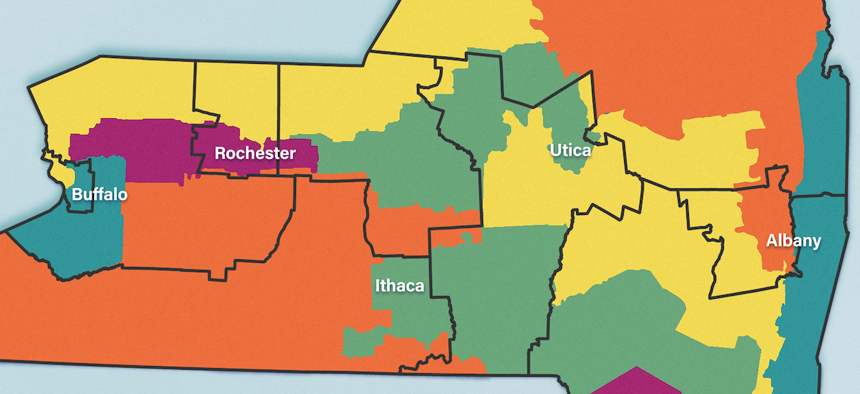Note: Excelsior will be going on an indefinite hiatus following this issue as I will be transitioning into the editor role at City & State’s sister publication New York Nonprofit Media. This is a bittersweet moment for me. I’m excited to take on this new role, but I’m sad to be leaving Excelsior behind. Nothing will ever compare with receiving dozens of emails saying “thank you” or expressing gratitude for explaining complicated topics. I’m so grateful for all of the support and all of our readers, and so thankful for everyone who has helped make this newsletter happen. So long for now. – Amanda
It makes census to me
It’s that special time of year, decade, actually, when lawmakers across the country redraw the district lines for congressional and state legislative seats.
The process of redistricting, which happens every 10 years, is aimed at ensuring that each state has equal representation based on any changes in population size. For instance, if the population increases significantly in a state, it would be entitled to greater representation. Changes made to various districts are based on census data that is collected the year prior in an effort to count the population. Remember that big push to collect census data last year, despite the ongoing COVID-19 pandemic? Now a lot of the information collected during that time has been released.
You’re probably wondering what this has to do with New York. Well, last week the U.S. Census Bureau published the first results of the census. While New York City’s population increased by 7.7%, the state will lose one congressional seat because the state’s population was 89 people short of keeping the seat. Census data will also be used to inform the redrawing of state Senate and Assembly lines.
State lawmakers are expected to redraw state lines in a way that keeps each district relatively equal in size, and dividing racial groups or communities in a way that would reduce or swell their voting powers is strictly prohibited. The term gerrymandering refers to the manipulation of district lines in an attempt to favor a particular political party or voting bloc.
In 2014, voters approved a constitutional amendment to form the Independent Redistricting Commission in an effort to eradicate problematic or politically motivated redistricting. The commission, which has 10 members, is expected to come up with a plan to redraw state lines in an equal and fair manner – more on that later!
If you’re curious to see what district you live in and other districts throughout the state, you can take a look at CUNY’s Redistricting & You map here.
By the numbers?
NY’s legislative districts and population size
- 26: Number of seats New York will have in the House of Representatives in 2022, down from 27 seats
- 63: The number of state Senate seats
- 150: The number of Assembly seats
- 20,201,249: New York state’s population as of April 1, 2020, up almost 1 million people from 2010
Mini history lesson
The 1965 Voting Rights Act
The U.S. Constitution says each state should choose representatives for Congress every two years and they should represent no more than 30,000 people. (At the time, that didn’t include Native Americans, and it counted only three-fifths of enslaved people.) The framers largely left it up to the state legislatures to figure out how and whether to break up their states. They did require an “enumeration,” or census, to be taken every 10 years to determine how many representatives each state sent to Congress. As the population grew, so did Congress, until it settled at 435 members in 1929. Now, the average Congress member represents more than 700,000 people. The 1965 Voting Rights Act prohibited redistricting to discriminate against people based on race. That change outlawed the division of Brooklyn’s Bedford-Stuyvesant neighborhood into multiple districts, for example, paving the way for Shirley Chisholm to become the first Black woman elected to Congress.
Influential New Yorkers
Who could impact the redrawing of state lines?
- Sean Patrick Maloney: As chair of the Democratic Congressional Campaign Committee, Maloney doesn’t have a say over redistricting, but he’ll be focused on retaining a Democratic majority in the midterm elections that will take place immediately after redistricting. Nationwide, Democrats will face an uphill battle to keep control of the House.
- Kathy Hochul: Since Gov. Andrew Cuomo has resigned and will soon leave office, Hochul will become governor and have the ability to veto or approve new plans for legislative districts submitted by the state Legislature, should they reject the plan recommended by the state Independent Redistricting Commission – more on that below.
- Andrea Stewart-Cousins and Carl Heastie: The state Senate majority leader and Assembly speaker will most likely face pressure to benefit Democrats in the redistricting process, despite the 2014 reforms.
Trust the process
How new district lines are approved
The 10-member bipartisan Independent Redistricting Commission has spent the summer holding hearings throughout the state to get input on redistricting. Using that feedback and the new census data, the commission will create maps for congressional and state legislative districts. A bipartisan group of at least seven members of the Independent Redistricting Commission have to approve a plan before Jan. 15, 2022, to send it to the state Legislature. If the commission can’t reach an agreement, then the plan with the most votes will go to the Legislature. The Legislature needs to approve the plan with a two-thirds vote to send it to the governor. The Legislature can only alter the plan after rejecting the Independent Redistricting Commission’s proposals twice, a move that might be tempting to Democrats with supermajorities in both chambers and national pressure to protect Democratic House seats.
– With reporting from Holly Pretsky


